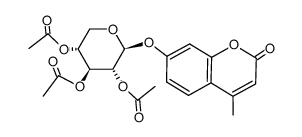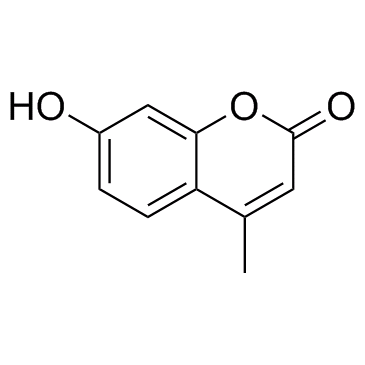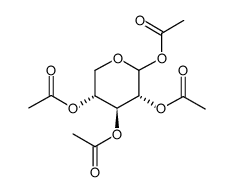(4-Methylumbelliferone)-β-D-xylopyranoside

(4-Methylumbelliferone)-β-D-xylopyranoside structure
|
Common Name | (4-Methylumbelliferone)-β-D-xylopyranoside | ||
|---|---|---|---|---|
| CAS Number | 6734-33-4 | Molecular Weight | 308.283 | |
| Density | 1.5±0.1 g/cm3 | Boiling Point | 572.1±50.0 °C at 760 mmHg | |
| Molecular Formula | C15H16O7 | Melting Point | 223ºC | |
| MSDS | USA | Flash Point | 217.3±23.6 °C | |
Use of (4-Methylumbelliferone)-β-D-xylopyranoside4-Methylumbelliferyl-β-D-xylopyranoside (MuX) can be used as substrate for the research of β-Xylosidase activity. 4-Methylumbelliferyl-β-D-xylopyranoside shows burst, steady-state kinetics, which supports the conclusion that hydrolysis of the glycosidic bonds for the substrate 4-Methylumbelliferyl-β-D-xylopyranoside is rapid[1][2]. |
| Name | 4-Methylumbelliferyl b-D-xylopyranoside |
|---|---|
| Synonym | More Synonyms |
| Description | 4-Methylumbelliferyl-β-D-xylopyranoside (MuX) can be used as substrate for the research of β-Xylosidase activity. 4-Methylumbelliferyl-β-D-xylopyranoside shows burst, steady-state kinetics, which supports the conclusion that hydrolysis of the glycosidic bonds for the substrate 4-Methylumbelliferyl-β-D-xylopyranoside is rapid[1][2]. |
|---|---|
| Related Catalog | |
| References |
| Density | 1.5±0.1 g/cm3 |
|---|---|
| Boiling Point | 572.1±50.0 °C at 760 mmHg |
| Melting Point | 223ºC |
| Molecular Formula | C15H16O7 |
| Molecular Weight | 308.283 |
| Flash Point | 217.3±23.6 °C |
| Exact Mass | 308.089600 |
| PSA | 109.36000 |
| LogP | 1.02 |
| Vapour Pressure | 0.0±1.7 mmHg at 25°C |
| Index of Refraction | 1.647 |
| Storage condition | −20°C |
| Personal Protective Equipment | Eyeshields;Gloves;type N95 (US);type P1 (EN143) respirator filter |
|---|---|
| Hazard Codes | T+ |
| Safety Phrases | S22-S24/25 |
| RIDADR | NONH for all modes of transport |
| WGK Germany | 3 |
|
~45% 
(4-Methylumbell... CAS#:6734-33-4 |
| Literature: Touisni, Nadia; Maresca, Alfonso; McDonald, Paul C.; Lou, Yuanmei; Scozzafava, Andrea; Dedhar, Shoukat; Winum, Jean-Yves; Supuran, Claudiu T. Journal of Medicinal Chemistry, 2011 , vol. 54, # 24 p. 8271 - 8277 |
|
~% 
(4-Methylumbell... CAS#:6734-33-4 |
| Literature: Carbohydrate Research, , vol. 100, p. 221 - 234 |
|
~% 
(4-Methylumbell... CAS#:6734-33-4 |
| Literature: Journal of Medicinal Chemistry, , vol. 54, # 24 p. 8271 - 8277 |
|
~% 
(4-Methylumbell... CAS#:6734-33-4 |
| Literature: Journal of Medicinal Chemistry, , vol. 54, # 24 p. 8271 - 8277 |
|
~% 
(4-Methylumbell... CAS#:6734-33-4 |
| Literature: Journal of Medicinal Chemistry, , vol. 54, # 24 p. 8271 - 8277 |
|
~% 
(4-Methylumbell... CAS#:6734-33-4 |
| Literature: Collection of Czechoslovak Chemical Communications, , vol. 24, p. 1099,1102 |
|
~% 
(4-Methylumbell... CAS#:6734-33-4 |
| Literature: Collection of Czechoslovak Chemical Communications, , vol. 24, p. 1099,1102 |
|
~% 
(4-Methylumbell... CAS#:6734-33-4 |
| Literature: Molecular Pharmacology, , vol. 79, # 3 p. 472 - 478 |
|
Mechanistic studies of active site mutants of Thermomonospora fusca endocellulase E2.
Biochemistry 38(30) , 9746-51, (1999) Endocellulase E2 from the thermophilic bacterium Thermomonospora fusca is a member of glycosyl-hydrolase family 6 and is active from pH 4 to 10. Enzymes in this family hydrolyze beta-1,4-glycosidic bo... |
|
|
A sulfated proteoglycan is necessary for storage of exocrine secretory proteins in the rat parotid gland.
Am. J. Physiol. Cell Physiol. 283(2) , C438-45, (2002) Sulfated proteoglycans have been proposed to play a role in the sorting and storage of secretory proteins in exocrine secretory granules. Rat parotid acinar cells expressed a 40- to 60-kDa proteoglyca... |
|
|
Simple measurement of glycosaminoglycan produced by cultured fibroblasts using 4-methylumbelliferyl beta-D-xyloside.
J. Biochem. Biophys. Methods 26(4) , 309-16, (1993) A simple and rapid method was devised for measurement of glycosaminoglycan produced by cultured cells. 4-Methylumbelliferyl-beta-D-xyloside was added to the medium of the cultured cells. After incubat... |
| 4-Methylumbelliferylb-D-xylopyranoside |
| MFCD00037607 |
| 4-METHYLUMBELLIFERYL-SS-D-XYLOSIDE |
| 2H-1-Benzopyran-2-one, 4-methyl-7-(β-D-xylopyranosyloxy)- |
| 4-METHYLUMBELLIFERYL-B-D-XYLOSIDE |
| 4-Methylumbelliferyl beta-D-xylopyranoside |
| 4'-METHYLUMBELLIFERYL-B-D-XYLOSE |
| 4-Methyl-2-oxo-2H-chromen-7-yl β-D-xylopyranoside |
| EINECS 229-784-4 |
| (4-Methylumbelliferone)-β-D-xylopyranoside |







![[5-(2,4-dioxopyrimidin-1-yl)-3,4-dihydroxy-oxolan-2-yl]methoxy-[hydroxy-(3,4,5-trihydroxyoxan-2-yl)oxy-phosphoryl]oxy-phosphinic acid structure](https://image.chemsrc.com/caspic/000/3616-06-6.png)

